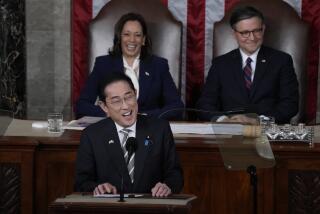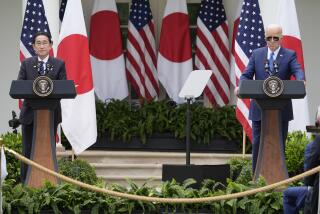A Toast, and a Push, for Opening Japanese Markets
- Share via
Once again a visit to Washington by the Prime Minister of Japan has come and gone, with toasts to amity and pledges of cooperation. But if you’re an average American you’re confused--or bored--by the rhetoric on both sides.
President Clinton and his aides talked tough--but actions such as calling for a lower-valued dollar are not going to erase the trade deficit with Japan, although they could attract more Japanese investment to the United States.
Prime Minister Kiichi Miyazawa and his party were enthusiastic, but their programs to stimulate the Japanese economy won’t spur much growth or buy much in U.S. goods.
Yet matters need not be so contradictory. Stripped of rhetoric the big question about Japan-U.S. relations is simple: What future for Japan is really in the interests of the ordinary American and the average Japanese?
And the answer is easy: A Japan open to investment and competition, offering other nations access to the second largest economy on earth and its own consumers access to the world’s goods.
But to understand why that’s difficult to achieve you have to know the background. Japan runs an export surplus with every other nation, including a $49-billion trade surplus last year with the United States. It exported $96 billion worth of goods to the United States but imported only $47 billion worth.
It’s not that Japan is super competitive--in fact, it lags in many industries. But in a multitude of ways it protects its home market not only from foreign goods but from investment by foreign competitors.
And investment is the secret to modern trade. Statistics from the U.S. and other governments show that in roughly 40% of international trade, goods move from one division of a multinational company to another. Toyota, Nagoya, shipping to Toyota, Kentucky, for example, or GE, Connecticut, shipping to GE, France.
The implications are profound. First, multinational company trade minimizes the effect of currency shifts. Company divisions don’t buy from other suppliers because the dollar or yen changes; they ship goods and adjust internal prices.
Secondly, such trade puts a premium on investing to get inside overseas markets. “Investment now dictates the composition and direction of trade,” says “Managing the World Economy,” a new book by Peter Cowhey and Jonathan Aronson, professors, respectively, at UC San Diego and USC.
In that light, Clinton Administration policy, as outlined by Treasury Secretary Lloyd Bentsen who called for a higher-valued yen, is counterproductive. It makes investment in Japan, or anywhere else, more expensive for U.S. companies.
If Bentsen is interested in helping U.S. companies, he should demand that Japanese car makers buy more U.S. auto parts. Instead, his cheap dollar policy encourages Japanese companies to build U.S. factories and compete over here. Perhaps that’s Clinton’s intent, but if so he should explain that to the American people.
Japan, on the other hand, has always made it difficult for foreign companies to break into its intricately organized home market. So a country with $3 trillion a year in economic activity and a market of 120 million people has remained heavily fenced off.
The irony is the policy has not served Japanese industry well. Sure, the world admires Japanese cars. But Japan has flubbed newer industries, notably computers and telecommunications networks, where its companies are technologically behind global competition.
Japan’s problem is that those new industries developed by responding to changing customer demands, but the restricted Japanese market wasn’t open to the mushrooming variety of computer and telecommunications products.
Also, the comfortable home market led Japanese companies to build more factory capacity than is proving useful. And trade surpluses, invested in land, buildings and stock markets, produced one of the worst financial bubbles in history.
In recent years, Japan has suffered recession as the government tried to let the air out of that bubble. Now the government claims to be stimulating the economy but U.S. experts are skeptical. They note that much of the $1-billion stimulus is going to shore up Japan’s shaky big banks.
Japan will probably remain in recession because the government is reluctant to change an economic structure, dating to postwar recovery, that penalizes consumers to finance industry. Japanese consumers pay on average 42% more for goods than U.S. consumers.
Why doesn’t Japan change? One reason is inertia--it has been ruled by the same political party for over 45 years. And another reason is fear. Japan has been protected by a U.S. military presence in Asia ever since World War II. Now it fears that presence going away with the end of the Cold War. “Asia is a dangerous place,” says Professor Haruo Shimada of Keio University, one of the leading scholars of Tokyo’s Council on Japan-U.S. Economic Relations. “We need America.”
A nice sentiment but the relationship is getting unhealthy. Japan, an economic giant, is protected by the U.S. military while it runs up trade surpluses that America then taps for such purposes as rebuilding Russia and helping Boris Yeltsin. In a way Japan is becoming a kind of vassal state.
And Americans pay a price--U.S. companies don’t get business in Japan; U.S. forces are committed to support the status quo in a country that badly needs to change as all of Asia is changing. The relationship is a relic of both World War II and the Cold War and it’s time we moved on.
So what should America do? It should demand openings of specific markets and investment opportunities for U.S. companies. Progress may be slow but could be steady. Don’t think of boxing and knockout punches, think of sumo wrestling, advises Professor Aronson. “In sumo you press all the time and push them in a direction. You won’t get them to go exactly where you want, but you will move them.”
More to Read
Inside the business of entertainment
The Wide Shot brings you news, analysis and insights on everything from streaming wars to production — and what it all means for the future.
You may occasionally receive promotional content from the Los Angeles Times.










